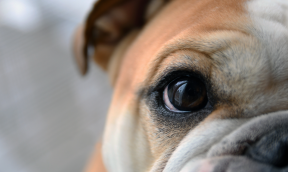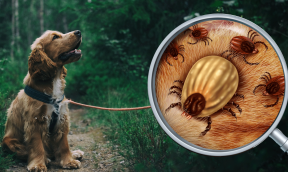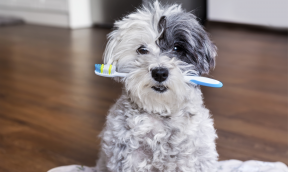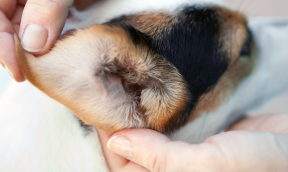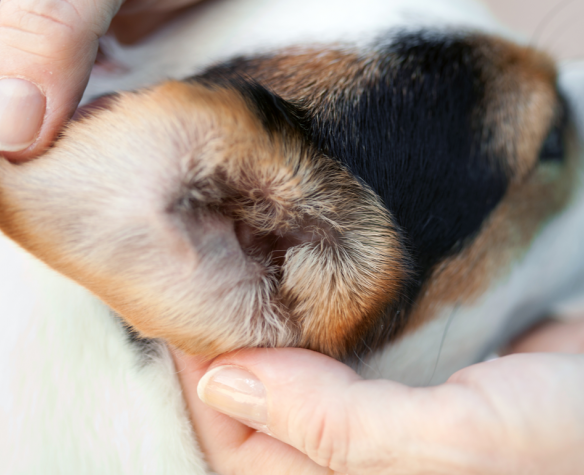
Cleaning your dog’s ears: 6 steps to good ear hygiene
Contents: 6 steps for cleaning your dog’s ears perfectly | How should you get ready to clean your dog’s ears? | How do the specific characteristics of a dog’s ears affect their hygiene? | Why should you inspect your dog’s ears from an early age? | How often should you check and clean your dog’s ears?
Cleaning your dog’s ears removes excess sebum and helps prevent ear infections. What’s more, some breeds are more prone to macerations and ear infections. So remember to adapt the frequency of care to your particular pet’s needs. So how do you clean your dog’s ears properly? Which products should you use? Francodex tells you everything.
6 steps to cleaning a dog’s ears perfectly
There are 6 essential steps involved in cleaning a dog’s ears really well:
- First, gather all the necessary equipment (cleaning solution, cotton wool, treats) so that you don’t have to get up during the treatment.
- Have your dog sit or lie down and build up its trust with petting and treats
- Slowly instil a few drops of lotion at the entrance to the ear canal. To avoid bacterial contamination, be careful not to let the tip of the bottle touch the ear.
- Gently massage the base of the ear for a few seconds to help loosen dirt and wax. This step feels like being petted for your dog who should enjoy it. Nevertheless, it will sometimes want to scratch its ear with its hind leg, by reflex, which is completely normal.
- Use a gauze compress to gently wipe the inside of the ear and any excess lotion, without going too deep. You can then clean the auricle with some gauze soaked in the product, or a dog cleaning wipe.
- Reward your dog with a treat!
After cleaning, dogs sometimes shake their ears vigorously to get rid of all the liquid.
How should you get ready to clean your dog’s ears?
Although cleaning your dog’s ears should be part of its routine, you should always make sure you do it in the right conditions and with the right equipment.
One bad experience often leaves a more lasting impression on a pet than numerous trouble-free cleaning sessions!
Creating the right environment for the cleaning session
Choose a quiet, comfortable place where your dog feels safe.
Prepare a few treats to reward or perhaps soothe it during the process. Have your pet sit or lie down in the position that is most comfortable for both of you, and reassure it with gentle stroking and soft words.
Using the right equipment to clean your dog’s ears
Use an ear cleaning solution specially formulated for dogs.
Francodex has an Ear Care Cleansing Lotion for dogs and cats for easy ear cleaning. It helps dissolve earwax but is gentle on the skin of the external auditory canal. This product helps keep your pet’s ears clean.
To clean your dog’s ears with a natural product, choose our cleaning lotion made from 99% natural products.
Finally, for your kitten or puppy, we recommend an ear-care cleansing lotion designed specially for the specific needs of young animals.
⚠️ Never use products containing alcohol or hydrogen peroxide, as they can irritate your dog’s ears. If you run out of ear cleaner, for dogs clean your dog’s ears with saline solution on some cotton wool. This sterile saline solution will serve to give them a quick clean.
Finally, we recommend using a gauze compress to clean away debris and wax. They are better than cotton wool, as they don’t leave threads that can stick to the skin or get stuck in the ear canal. If you don’t have a gauze pad, you can also use cloth wipes or washable make-up removal squares, as long as there are no fibres that might be left in the ear canal.
💡Check out our article about caring for your dog’s paw pads
How do the specific characteristics of a dog’s ears affect their hygiene?
A dog’s ear is different from a human’s and needs to be cleaned very cautiously.
This is because the L-shaped external auditory canal first descends vertically down the dog’s cheek and then turns at right angles towards the skull, ending in the eardrum. This canal contains the glands that secrete sebum in the dog’s ear.
Its particular shape encourages the accumulation of earwax at the bottom of the canal, which cannot always evacuate on its own.
All dogs have hairs in the ear canal, whose role is to help dirt and foreign bodies to move up and out: this is known as ciliary clearance.
Unfortunately, this doesn’t work equally well in all breeds of dog. This can then result in accumulation, rather than elimination. This accumulation, combined with the natural heat and humidity of the ear canal, encourages macerations and can therefore be the cause of ear infections.
⚠️ The eardrum is the last part of the external canal. This membrane plays a key role in your dog’s hearing and partly protects the inner ear. When cleaning, you must never go as far as the eardrum, as a tear can affect your pet’s hearing and balance, sometimes irreversibly.
🐶Are all dogs equal when it comes to ear cleaning? Some breeds are more prone to macerations and ear infections:
- dogs with floppy ears such as Cocker Spaniels, Basset Hounds, Labradors, Golden Retrievers, Setters, etc.;
- dogs with a lot of hair, or hair that doesn’t stop growing, in the ear canal, such as Poodles, Bichons, Shih Tzus, etc.;
- dogs with a narrower ear canal, such as Shar Peis, Bulldogs, etc.
Finally, some breeds, such as the Golden Retriever or German Shepherd, are more prone to allergic diseases (atopy), which can sometimes lead to recurrent ear infections.
If you’re not sure whether your pet is particularly sensitive around the ears, ask your vet for advice.
Why inspect your dog’s ears from an early age?
Like oral hygiene, there are several good reasons why cleaning your dog’s ears is part of a routine that should be introduced as soon as your new pet arrives home.
Making hygiene a well-accepted routine
Getting the animal used to being handled, examined and even treated is a component of its “medical training”.
From an early age, your dog needs to get used to ear care, as it helps prevent infections and other health problems.
💡Check out our article about looking after your dog’s eyes
To do this, start by gently touching and massaging the dog’s ears during quiet moments, rewarding them with praise or a treat.
Wipe your dog’s ears with a multi-purpose cleaning wipe for dogs. Little by little, increase how long and how firmly you handle the dog’s ears. Gradually start to use standard care equipment for dog’s ears.
Remember to associate each step with a positive experience for your pet. Patience and regularity are the key. This learning process will also strengthen the bonds between you and your pet.
🐶 Removing hair from the ear canal: hairs in the ears of long-haired or floppy-eared dogs, or dogs with a lot of hair in the ear canal, should be removed to prevent infections - such is the case, for example, with Poodles, Bichons and Yorkies. Hair removal should be carried out every month or two to prevent the build-up of hair and dirt. Your vet can explain how to do this, or your groomer can take care of it for you.
Preventing infections
Cleaning a dog’s ears prevents infection by removing excess wax, dirt and debris that can trap moisture and encourage the growth of bacteria and yeasts.
Dogs are susceptible to ear infections, which can occur when allergens, parasites or poor hygiene disrupt the ear’s natural balance.
Signs of infection in a dog’s ear include:
- redness,
- itching,
- swelling,
- abnormal secretions,
- a bad smell,
- behavioural signs such as frequent ear scratching and abnormal head movements.
By cleaning your pet’s ears regularly, you can reduce these risks and protect its health.
Consult a vet as soon as possible if any symptoms of infection appear. In such cases, cleaning its ears is not useful and could even be dangerous!
🐶 Pourquoi mon chien a-t-il du noir dans les oreilles ? Le noir dans les oreilles d’un chien est souvent du cérumen accumulé, parfois mélangé à de la saleté ou à des débris. Cela peut également indiquer une infection par des levures ou des bactéries, ou une infestation par la gale des oreilles. En cas de doute, consultez votre vétérinaire.
How often should you check and clean your dog’s ears?
How often you should clean your dog’s ears depends on its breed, age and medical condition.
If your pet’s ears are upright and rarely dirty, one or two cleans a month will be enough to remove any dirt that may have accumulated, without harming the internal flora. However, floppy or hairy ears often need weekly cleaning.
On the other hand, if your pet’s ears need cleaning more than once a week, or if signs of infection appear, please consult your vet.
Special cases: the ears of puppies and older dogs or those suffering from ear disorders should be monitored and cleaned more frequently, as recommended by the vet.
Article written with the assistance of
Dr Stéphanie Padiolleau, veterinary surgeon

